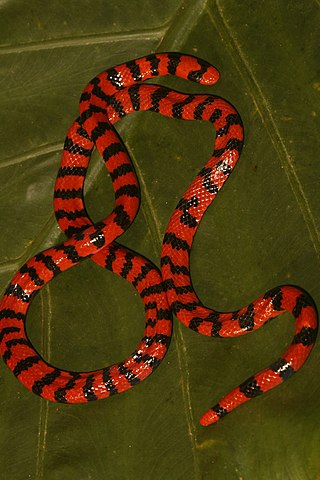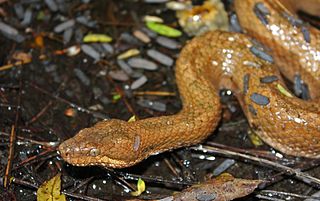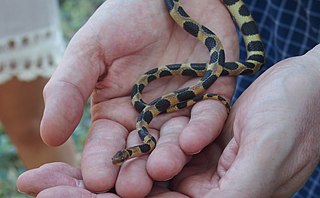
The Aniliidae are a monotypic family created for the monotypic genus Anilius that contains the single species Anilius scytale. Common names include the American pipe snake and false coral snake. It is found in South America. This snake possesses a vestigial pelvic girdle that is visible as a pair of cloacal spurs. It is ovoviviparous. It is non-venomous, and its diet consists mainly of amphibians and other reptiles. Two subspecies are recognized, including the nominate subspecies described here.

The Tropidophiidae, common name dwarf boas or thunder snakes, are a family of nonvenomous snakes found from Mexico and the West Indies south to southeastern Brazil. These are small to medium-sized fossorial snakes, some with beautiful and striking color patterns. Currently, two living genera, containing 34 species, are recognized. Two other genera were once considered to be tropidophiids but are now known to be more closely related to the boids, and are classified in the subfamily Ungaliophiinae. There are a relatively large number of fossil snakes that have been described as tropidophiids, but which of these are more closely related to Tropidophis and Trachyboa and which are more closely related to Ungaliophis and Exiliboa is unknown.

Tropidophis melanurus, commonly known as the dusky dwarf boa, Cuban wood snake, or Cuban giant dwarf boa, is a nonvenomous dwarf boa species found mainly in Cuba. There are three subspecies that are recognized as being valid, including the nominate subspecies described here.

Tropidophis, common name Caribbean dwarf boas, wood snakes or West Indian wood snakes, is a genus of dwarf boas endemic to the West Indies and South America. Currently, either 17 or 33 species are recognized, depending on the authority.
Tropidophis fuscus is a nonvenomous dwarf boa species endemic to Cuba. There are no subspecies that are recognized as being valid.
Tropidophis greenwayi is a nonvenomous dwarf boa species endemic to the Caicos Islands. Two subspecies are currently recognized, including the nominate subspecies described here.
Tropidophis battersbyi, also known commonly as Battersby's dwarf boa and the Ecuadorian dwarf boa, is a species of snake in the family Tropidophiidae. The species is endemic to Ecuador.

Tropidophis feicki, also known commonly as the broad-banded dwarf boa, the broad-banded trope, and Feick's dwarf boa, is a species of non-venomous snake in the family Tropidophiidae. The species is endemic to Cuba.
Tropidophis haetianus, the Haitian dwarf boa, is a species of snake in the family Tropidophiidae. The species is endemic to the island of Hispaniola in the West Indies.
Tropidophis maculatus, or the spotted red dwarf boa, is a species of snake in the family Tropidophiidae. The species is endemic to Cuba.
Tropidophis nigriventis, or the black-bellied dwarf boa, is a species of snake in the family Tropidophiidae. The species is endemic to Cuba.
Tropidophis pardalis, also known commonly as the leopard dwarf boa and the spotted brown trope, is a species of snake in the family Tropidophiidae. The species is endemic to Cuba.
Tropidophis pilsbryi, commonly known as Pilsbry's dwarf boa or the Cuban white-necked dwarf boa, is a species of snake in the family Tropidophiidae. The species is endemic to Cuba.

Tropidophis semicinctus, also known commonly as the banded dwarf boa, the yellow-banded dwarf boa, and the yellow-banded trope, is a species of snake in the family Tropidophiidae. The species is endemic to Cuba.

Tropidophis taczanowskyi, also known commonly as Taczanowski's dwarf boa, is a species of snake in the family Tropidophiidae. The species is native to northern South America.
Tropidophis wrighti, commonly known as Wright's dwarf boa, the gracile banded dwarf boa, and the gracile banded trope, is a species of snake in the family Tropidophiidae. The species is endemic to Cuba.

Bothrocophias hyoprora, or the Amazonian toad-headed pitviper, is a species of venomous snake in the family Viperidae. It is endemic to north-western South America.
Bothrops marajoensis, or the Marajó lancehead, is a species of venomous snake in the family Viperidae. It is endemic to Brazil.

Bothrocophias microphthalmus, or the small-eyed toad-headed pit viper, is a species of venomous snake in the family Viperidae. The species is endemic to northwestern South America.








